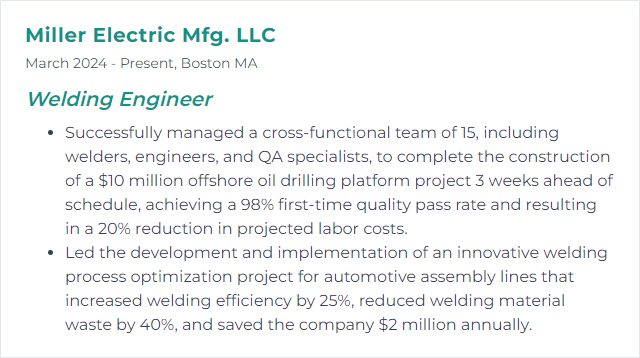Top 12 Welding Engineer Skills to Put on Your Resume
Hiring managers skim. Welding engineers who surface a sharp mix of technical depth and people sense get noticed. The 12 skills below anchor real-world performance and help a resume ring true.
Welding Engineer Skills
- MIG Welding
- TIG Welding
- Stick Welding
- Flux-Cored Arc Welding
- Laser Welding
- Robotic Welding
- CAD Software
- Metallurgy
- Welding Codes (e.g., AWS, ASME)
- Non-Destructive Testing
- Welding Simulation
- Project Management
1. MIG Welding
MIG welding, more formally Gas Metal Arc Welding (GMAW), is a semi-automatic or automatic arc process that feeds a consumable wire under shielding gas to protect the molten pool from contamination.
Why It's Important
GMAW/MIG delivers speed, versatility across steels and aluminum, and clean beads with limited post-weld cleanup. In production or repair, that means throughput without sacrificing quality.
How to Improve MIG Welding Skills
Focus on parameters and consistency—small tweaks pay big dividends.
Equipment care: Keep liners, contact tips, nozzles, and drive rolls clean and matched to wire size. Replace worn parts before feeding issues snowball.
Dial-in parameters: Match voltage, wire feed speed, stickout, and inductance to material thickness and wire type. Verify heat input; avoid cold lap and burn-through alike.
Shielding gas and wire choice: Select gas blends (e.g., Ar/CO2 variants) and wire chemistry to suit base metal and position. Store wire dry; purge lines to prevent porosity.
Technique discipline: Maintain a steady travel speed, 10–15° push angle for solid wire, and consistent stickout. Watch the leading edge of the puddle, not the arc light.
Spatter control: Optimize parameters, use clean ground, and apply anti-spatter only where necessary. Proper settings beat chemicals every time.
Practice with intention: Short, frequent runs on coupons, then destructive tests and macro-etches to verify penetration and fusion. Feedback tightens skill.
How to Display MIG Welding Skills on Your Resume
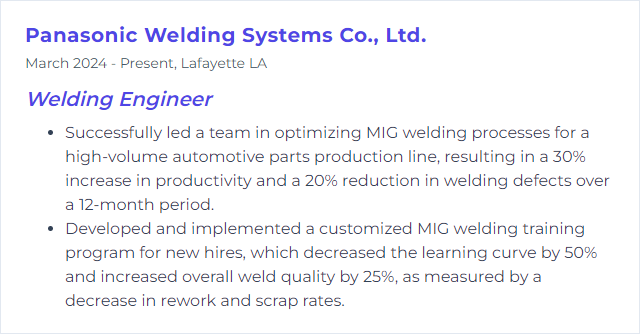
2. TIG Welding
TIG welding, or Gas Tungsten Arc Welding (GTAW), uses a non-consumable tungsten electrode with inert shielding gas for high-precision, low-spatter welds on thin sections and reactive alloys.
Why It's Important
GTAW is the go-to for clean, precise welds on stainless, aluminum, titanium, and thin-gauge parts. When distortion and cosmetic finish matter, TIG is the scalpel.
How to Improve TIG Welding Skills
Setup and prep: Size the tungsten, cup, and gas lens for the joint. Clean base metal and filler scrupulously. Contamination ruins good work.
Shielding mastery: Argon dominates, but helium blends can boost penetration on thicker sections. Guard against drafts; extend post-flow to protect the cooling weld and tungsten.
Control the variables: Steady torch angle, tight arc length, and rhythmic filler addition. Foot pedal or fingertip controls should feel second nature.
Parameter optimization: AC balance and frequency for aluminum, pulse settings for heat control, and amperage matched to thickness. Log effective recipes.
Post-weld care: For critical alloys, consider stress relief or pickling/passivation as specified. Verify color and oxide formation as a quick sanity check.
How to Display TIG Welding Skills on Your Resume
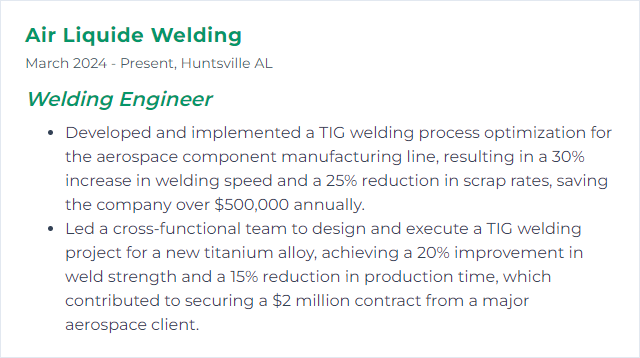
3. Stick Welding
Stick welding, or Shielded Metal Arc Welding (SMAW), is a manual process using a flux-coated consumable electrode. It thrives outdoors, on dirty steel, and in tight access where other processes stumble.
Why It's Important
Rugged, portable, cost-effective. For construction, maintenance, and field repair, SMAW is the workhorse that keeps operations moving when conditions aren’t perfect.
How to Improve Stick Welding Skills
Right electrode: Match rod type and diameter (e.g., 6010, 7018) to base metal, position, and required properties. Store low-hydrogen rods in dry, heated conditions.
Current and arc length: Set amperage per rod size and keep the arc about the diameter of the electrode (or slightly less). Too long, and spatter climbs while penetration drops.
Angles and motion: 10–15° drag on most fillets and flats. Short, controlled weaves only when needed for width and tie-in.
Prep matters: Grind to bright metal, bevel where necessary, and ensure root gaps are consistent. Clean work means fewer inclusions and better fusion.
Safety and repetition: PPE, ventilation, and steady practice on varied positions. Break the slag, inspect, adjust, repeat.
How to Display Stick Welding Skills on Your Resume
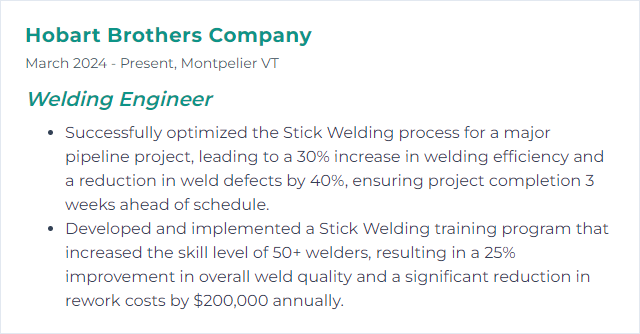
4. Flux-Cored Arc Welding
Flux-Cored Arc Welding (FCAW) feeds a tubular wire filled with flux. It delivers high deposition rates, deep penetration, and strong out-of-position performance. Available as gas-shielded (FCAW-G) and self-shielded (FCAW-S).
Why It's Important
FCAW is fast and forgiving, especially on thicker sections and structural work. Slag coverage protects the pool, while productivity stays high.
How to Improve Flux-Cored Arc Welding Skills
Wire and flux selection: Choose wire to match base metal, position, and required toughness. Confirm diffusible hydrogen levels for critical work.
Machine tuning: Voltage, wire feed speed, and stickout control bead shape and fusion. Keep drive rolls and liners sized and clean for stable feeding.
Technique: Slight drag angle, consistent travel speed, and controlled weave where needed. Maintain proper work angle to avoid undercut.
Environmental control: Shield wind for FCAW-G and respect limits for FCAW-S. Moisture is the quiet saboteur; keep consumables dry.
Inspect and verify: Regular bend tests, macro-etch checks, and procedure verification to confirm parameters deliver the intended properties.
How to Display Flux-Cored Arc Welding Skills on Your Resume

5. Laser Welding
Laser welding uses a concentrated beam to fuse materials with minimal heat input and distortion. Fiber lasers dominate modern setups for speed, precision, and tight process control.
Why It's Important
High accuracy, small heat-affected zones, and clean seams—ideal for thin gauges, complex assemblies, and high-value alloys.
How to Improve Laser Welding Skills
Nail the parameters: Balance power, speed, focus, and spot size for the joint design. Monitor keyhole stability where applicable.
Joint and surface prep: Clean, consistent fit-up with accurate fixturing. Minor gap changes can swing penetration wildly.
Pick the right optics: Beam delivery, scanners, and protective windows must be maintained and matched to the application.
Advanced controls: Beam oscillation, pulse modulation, and real-time sensors help tame porosity and cracking.
Post-process as needed: Heat treatment or light finishing for appearance or property tuning—only where it adds value.
Safety first: Class-specific eye protection, enclosures, and interlocks. No shortcuts.
How to Display Laser Welding Skills on Your Resume
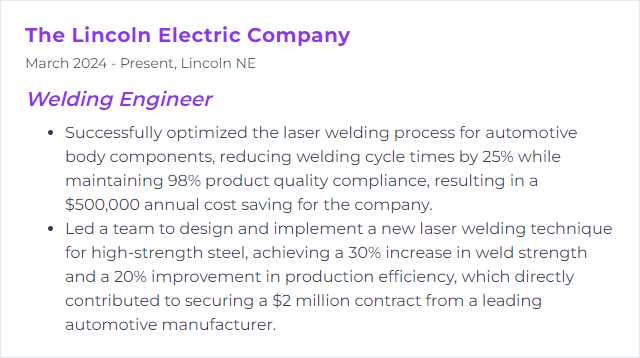
6. Robotic Welding
Robotic welding deploys programmable arms to execute repeatable welds with speed and consistency. From fixed cells to cobots, automation continues to broaden access.
Why It's Important
Consistency, throughput, and traceability. Robots reduce variability, cut rework, and improve safety for repetitive or hazardous tasks.
How to Improve Robotic Welding Skills
Offline programming and simulation: Validate reach, paths, collisions, and cycle time before touching the cell. Fewer surprises, faster launch.
TCP and calibration: Precise torch center-point calibration, tool offsets, and fixture datums are non-negotiable for accuracy.
Seam tracking and sensing: Add through-arc sensing, laser vision, or touch-sensing to handle real-world variation in fit-up.
Preventive maintenance: Nozzle cleaning, tip replacement, and cable management keep arcs stable and uptime high.
Standardize WPS and QA: Lock down parameters, create clear recovery procedures, and build in in-process checks.
Train the team: Operators, programmers, and inspectors need common language and documented playbooks.
How to Display Robotic Welding Skills on Your Resume

7. CAD Software
CAD (Computer-Aided Design) tools let welding engineers model parts, joints, fixtures, and assemblies in 2D/3D, then communicate requirements clearly with proper weld symbols and annotations.
Why It's Important
Good CAD habits tighten fit-up, reduce rework, and align design with manufacturing. Less ambiguity on the drawing means fewer shop-floor detours.
How to Improve CAD Software Skills
Master parametric modeling: Robust sketches, constraints, and assemblies that tolerate change without breaking.
Weld symbols and MBD: Use standardized welding symbols, GD&T where needed, and model-based definitions for unambiguous intent.
Template and library hygiene: Build reusable joints, symbol palettes, and title block standards. Consistency saves hours.
Design for welding: Consider access, distortion, sequence, and fixture points directly in the model. Fewer hidden traps.
Collaborate in real time: Version control, change tracking, and markup workflows keep teams aligned.
Link to CAM/CAE: Use integrated simulation or export cleanly to analysis tools for distortion and stress checks.
How to Display CAD Software Skills on Your Resume
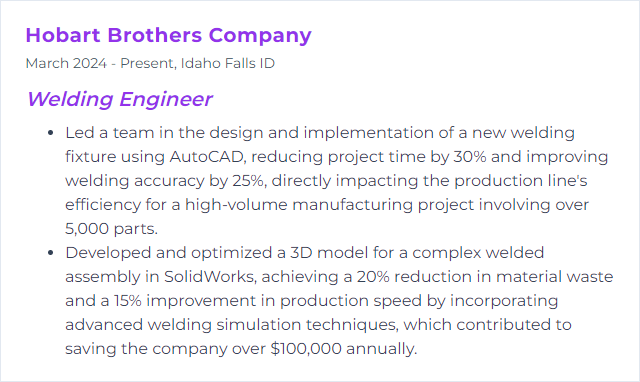
8. Metallurgy
Metallurgy studies how metals and alloys behave—composition, microstructure, transformations, and properties—so welds can be designed and executed to meet real service demands.
Why It's Important
Pick the wrong filler, skip preheat, or ignore heat input and you invite cracking, low toughness, or premature failure. Metallurgy turns guesswork into engineering.
How to Improve Metallurgy Skills
Microstructure awareness: Understand HAZ regions, grain growth, and phase transformations in common alloys (carbon steels, HSLA, stainless, nickel, aluminum, titanium).
Procedure discipline: Develop and qualify WPS/PQR with defined preheat, interpass, and PWHT. Verify mechanicals and impact/toughness where required.
Hydrogen control: Manage moisture, baking, and handling for low-hydrogen processes. Track diffusible hydrogen risks in high-strength steels.
Heat input and cooling rates: Calculate heat input and plan sequences/fixtures to control distortion and properties.
Failure literacy: Read fractures, perform root-cause analysis, and tie fixes back to material behavior.
How to Display Metallurgy Skills on Your Resume
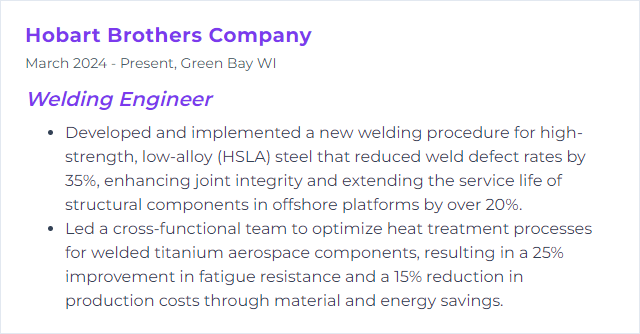
9. Welding Codes (e.g., AWS, ASME)
Welding codes and standards—such as AWS D1.1, ASME Section IX, API 1104, and relevant ISO standards—define rules for qualification, fabrication, inspection, and acceptance.
Why It's Important
Codes protect safety and quality. They align expectations across design, fabrication, and inspection so products perform as intended.
How to Improve Welding Codes (e.g., AWS, ASME) Skills
Know the scope: Identify which code governs a project and which editions apply. Map code clauses to project requirements early.
Qualify properly: Prepare solid WPS/PQR and welder qualifications. Maintain traceable records and renewal schedules.
Document everything: Procedure packages, material certs, consumable control logs, and inspection reports—organized and audit-ready.
Inspection planning: Define VT, PT, MT, UT, RT, or PAUT stages, hold points, and acceptance criteria per code and contract.
Close gaps fast: When nonconformances arise, root cause, disposition, and corrective actions should be crisp and timely.
Stay current: Track code updates, interpretations, and errata. Share changes with the team before they bite.
How to Display Welding Codes (e.g., AWS, ASME) Skills on Your Resume
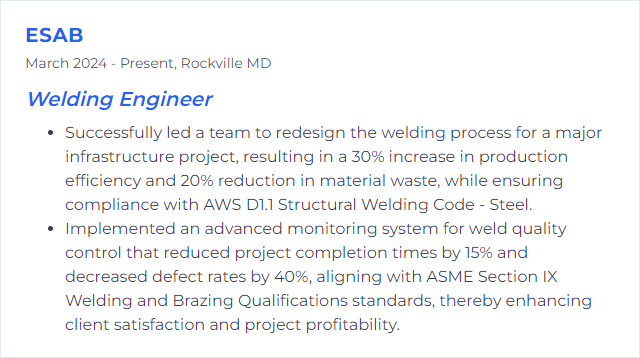
10. Non-Destructive Testing
Non-Destructive Testing (NDT) assesses materials and welds without damage. Common methods include VT, PT, MT, UT, RT, PAUT, TOFD, and eddy current.
Why It's Important
NDT catches defects early, protects service integrity, and reduces costly failures. Smart inspection beats late-stage surprises.
How to Improve Non-Destructive Testing Skills
Method selection: Match the technique to likely flaws, geometry, and access. Combine methods for critical joints.
Calibrate and validate: Use appropriate reference blocks, set sensitivity properly, and perform system checks before inspections.
Operator competence: Maintain training and certifications. Cross-train to interpret tricky indications.
Automate where it helps: Consider scanners or phased array systems for repeatability and data-rich records.
Data discipline: Store scans and reports with traceability. Trend results to guide process improvements.
How to Display Non-Destructive Testing Skills on Your Resume
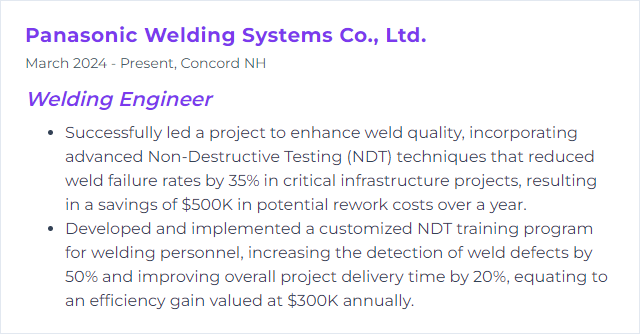
11. Welding Simulation
Welding simulation models thermal cycles, distortion, residual stress, and microstructural effects before metal is ever cut.
Why It's Important
It shrinks trial-and-error, guides fixture design, and predicts risk zones so procedures land closer to right the first time.
How to Improve Welding Simulation Skills
Accurate inputs: Use realistic heat source models, convection/radiation boundaries, and temperature-dependent material data.
Mesh intelligently: Refine where gradients are steep and simplify where they aren’t. Balance accuracy with solve time.
Calibrate with reality: Validate against thermocouples, bead geometry, and distortion measurements. Adjust and re-run.
Link to process: Convert results into actionable WPS limits, sequence plans, and fixturing strategies.
Iterate quickly: Build parametric studies to explore travel speed, heat input, or sequence effects without starting over.
How to Display Welding Simulation Skills on Your Resume
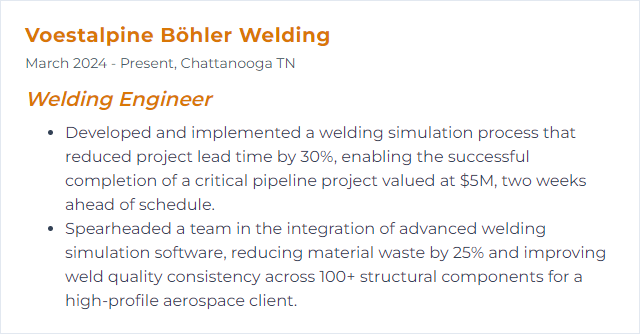
12. Project Management
Project management for welding ties scope, schedule, cost, quality, and risk into one coherent plan—from design handoff to final inspection.
Why It's Important
It keeps teams aligned, budgets intact, and deliverables compliant. Chaos shrinks, predictability grows.
How to Improve Project Management Skills
Define scope early: Clarify code requirements, materials, NDT levels, and acceptance criteria. No ghosts later.
Plan the work: Build a realistic schedule with weld sequences, fixture timing, and procurement lead times. Protect the critical path.
Manage risk: Use FMEAs, risk registers, and mitigation triggers. Revisit often, not just once.
Control change: Formalize design and process changes with impact analysis on cost, schedule, and quality.
Track performance: Monitor KPIs—first-pass yield, repair rates, cycle time, and consumable usage. Act on trends.
Communicate crisply: Short, frequent updates with action owners and due dates. Decisions documented.
Close the loop: Lessons learned feed the next WPS, fixture, and estimate. Continuous improvement, not accidental progress.
How to Display Project Management Skills on Your Resume
